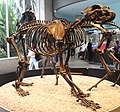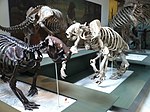hominin Paleolithic diet. The Paleolithic covers roughly 2.8 million years, concurrent with the Pleistocene, and includes multiple human ancestors with their... 39 KB (5,196 words) - 04:35, 26 April 2024 |
 | diet, Paleo diet, caveman diet, or Stone Age diet is a modern fad diet consisting of foods thought by its proponents to mirror those eaten by humans during... 37 KB (4,501 words) - 08:39, 1 May 2024 |
 | The Late Pleistocene to the beginning of the Holocene saw numerous extinctions of predominantly megafaunal (typically defined as having body masses over... 201 KB (19,621 words) - 06:54, 13 May 2024 |
 | Homo longi (redirect from Dragon Man (archaic human)) is broadly anatomically similar to other Middle Pleistocene Chinese specimens. Like other archaic humans, the skull is low and long, with massively developed... 19 KB (2,152 words) - 03:26, 11 May 2024 |
David Perlmutter (category Low-carbohydrate diet advocates) and paleolithic diets has been criticized by physicians and is not supported by anthropological research on the Pleistocene human diet. For example, Nash... 18 KB (1,561 words) - 12:39, 30 April 2024 |
 | (June 1998). "Late Pleistocene human population bottlenecks, volcanic winter, and differentiation of modern humans". Journal of Human Evolution. 34 (6):... 253 KB (26,320 words) - 18:49, 11 May 2024 |
 | Procoptodon (category Pleistocene mammals of Australia) among the Pleistocene macropodids throughout the continent shows that this species was adapted to a tougher diet than any other extinct Pleistocene sthenurine... 20 KB (2,027 words) - 03:32, 24 April 2024 |
 | Arctodus (category Pleistocene bears) extinct genus of short-faced bear that inhabited North America during the Pleistocene (~2.5 Mya until 12,800 years ago). There are two recognized species:... 230 KB (20,750 words) - 06:14, 8 May 2024 |
 | Panthera spelaea (redirect from Upper Pleistocene Eurasian cave lion) "Pleistocene Panthera leo spelaea (Goldfuss 1810) remains from the Balve cave (NW Germany) - a cave bear, hyena den and middle palaeolithic human cave... 42 KB (4,322 words) - 03:33, 28 April 2024 |
 | Gigantopithecus (category Pleistocene primates) Mörike, D.; Pushkina, D.; Jaeger, J.-J. (2017). "Flexibility of diet and habitat in Pleistocene South Asian mammals: Implications for the fate of the giant... 48 KB (5,351 words) - 15:14, 29 March 2024 |
 | Protein poisoning (redirect from Rabbit Diet Disease) "Climatic variability and plant food distribution in Pleistocene Europe: Implications for Neanderthal diet and subsistence". Quaternary Science Reviews. 29... 12 KB (1,397 words) - 18:07, 14 April 2024 |
advances allowed human geographic dispersal, cultural innovations, and changes to diet and behavior. Additionally, creating fire allowed human activity to... 52 KB (6,226 words) - 05:30, 5 May 2024 |
 | Paleolithic (category Pleistocene) (2006). "Implications of Plio-Pleistocene Hominin Diets for Modern Humans" (PDF). In Ungar, P. (ed.). Early Hominin Diets: The Known, the Unknown, and... 110 KB (11,844 words) - 00:47, 30 April 2024 |
 | Neanderthal (section Interbreeding with modern humans) "Climatic variability and plant food distribution in Pleistocene Europe: Implications for Neanderthal diet and subsistence". Quaternary Science Reviews. 29... 329 KB (35,808 words) - 23:06, 11 May 2024 |
 | Pleistocene Park (Russian: Плейстоценовый парк, romanized: Pleystotsenovyy park) is a nature reserve on the Kolyma River south of Chersky in the Sakha... 104 KB (9,029 words) - 12:22, 26 April 2024 |
 | Sus (genus) (section Diet and foraging) Han, 1987 – Early Pleistocene of China †Sus bijiashanensis Han et al., 1975 – Early Pleistocene of China †Sus falconeri – Pleistocene of the Siwalik region... 43 KB (4,007 words) - 07:10, 30 April 2024 |
 | Homo erectus (category Pleistocene primates) əˈrɛktəs/; meaning "upright man") is an extinct species of archaic human from the Pleistocene, with its earliest occurrence about 2 million years ago. Its specimens... 136 KB (15,777 words) - 04:45, 13 May 2024 |
 | morphometric analyses of a late Middle Pleistocene hominin mandible from Hualongdong, China". Journal of Human Evolution. 182. doi:10.1016/j.jhevol.2023... 15 KB (1,420 words) - 05:32, 7 April 2024 |
 | Barbary macaque (section Diet) England, dating to the Middle Pleistocene, at 53 degrees latitude, are amongst the northernmost records of non-human primates. Barbary macaques have... 49 KB (5,570 words) - 14:11, 10 May 2024 |
 | Homo antecessor (category Pleistocene primates) human recorded in the Spanish Sierra de Atapuerca, a productive archaeological site, from 1.2 to 0.8 million years ago during the Early Pleistocene.... 68 KB (8,647 words) - 13:38, 7 May 2024 |
 | Mammoth (category Pleistocene proboscideans) Middle-Late Pleistocene), Mammuthus exilis on the Channel Islands of California (Late Pleistocene), and Mammuthus creticus on Crete (Early Pleistocene). Like... 43 KB (4,622 words) - 19:09, 12 May 2024 |
 | Hippopotamus gorgops (category Pleistocene Artiodactyla) appeared during the late Pliocene-Early Pleistocene, and became extinct during the early Middle Pleistocene. The species was described by German scientist... 12 KB (1,103 words) - 05:10, 25 April 2024 |
 | Ground sloth (category Pleistocene xenarthrans) G.; Bennett, M.R. (2018-04-25). "Footprints preserve terminal Pleistocene hunt? Human-sloth interactions in North America". Science Advances. 4 (4):... 53 KB (5,477 words) - 00:21, 13 May 2024 |
 | Deer (redirect from Human interactions with deer) economic significance to humans. Deer meat, known as venison, is highly nutritious. Due to the inherently wild nature and diet of deer, venison is most... 95 KB (10,305 words) - 09:45, 13 May 2024 |
 | Cave bear (category Pleistocene bears) prehistoric species of bear that lived in Europe and Asia during the Pleistocene and became extinct about 24,000 years ago during the Last Glacial Maximum... 43 KB (4,844 words) - 15:43, 13 May 2024 |
 | Lower Paleolithic (section Middle Pleistocene) Erwan; Puaud, Simon; Abdessadok, Salah (June 2011). "Lower and Middle Pleistocene human settlements recorded in fluvial deposits of the middle Loire River... 15 KB (1,790 words) - 17:02, 29 April 2024 |
 | Ursus rossicus (redirect from Pleistocene small cave bear) (the Pleistocene small cave bear) is an extinct species of bear that lived in the steppe regions of northern Eurasia and Siberia during the Pleistocene. Vereshchagin... 6 KB (610 words) - 00:07, 4 May 2024 |



